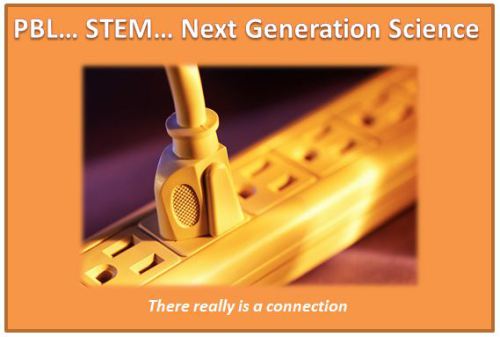STEM…PBL… Next Gen Science … A Natural, Essential and Practical Connection

“Give the pupils something to do, not something to learn; and the doing is of such a nature as to demand thinking; learning naturally results.” – John Dewey
As a long-time advocate of STEM education and more recently Project Based Learning (PBL), I can’t help but see how these two concepts really do complement one another. Both STEM and PBL depend on a student need to know and inquiry which allows for higher level learning. Additionally, they both facilitate and promote important 21st century competencies. Since STEM includes the integration of the curricular areas of Science, Technology, Math, and Engineering, this intertwining allows for connections and an authenticity that is essential to both PBL and STEM.
Best practices behind the disciplines of STEM are changing. The Common Core State Standards places a strong emphasis on scientific literacy involving student writing about process. It is no longer acceptable to just find the answer to a math equation. Students must be able to apply their math skills to the real world. The Next Generation Science Standards promote the kind of application found in engineering and technology,demanding formulation of a problem that is solved by design thinking. These standards state, “Strengthening the engineering aspects of the Next Generation Science Standards will clarify for students the relevance of science, technology, engineering and mathematics (the four STEM fields) to everyday life.”
PBL, with its emphasis on authenticity, connections, inquiry, and process, is able to provide these disciplines a necessary pedagogy. It allows students to own their learning while promoting the inquiry of science, resourcefulness of technology, design principles found in engineering, and application of math. Integrating the subjects encourages student innovation, promotes authentic learning, and allows students to see connections with their community and between content areas. It’s true; PBL can be the delivery method as well as the connector of separate content areas.
As I reflect on my STEM practice, I am aware of the integral way PBL facilitates student learning. One of my favorite STEM projects involves a spin-off of a Rube Goldberg study. Sixth graders work in collaborative teams to design a system utilizing necessary scientific elements, while incorporating detailed constraints. They learn significant science content relating to systems and simple machines and math content involving measurement and scale. Student teams communicate, debate, and tinker using the process of revision and reflection. Design thinking is evident as students carefully plan using programs such as SketchUp to put thoughts on paper, and later transfer their ideas to a real working model. Excitement swells as students prepare to test their contraptions before mentor engineers.
I have often used the program West Point Bridge Design to promote mathematics and physics skills with seventh grade students. Working in collaborative contractor teams, students uncover the STEM content area in order to design a computer simulated bridge. They answer the Driving Question, “How can we build a bridge at the lowest cost possible?” Through a formative learning process students experience the rigorous math and physics found in engineering while practicing 21st century competencies.
In another STEM project that incorporates a national competition called Future City, eighth grade students use science and math to design a future city using the popular simulation SIM City. They later transform their creation to a design of a model of a city built using mathematical scale. Engineer mentors provide the important guidance and public audience that leads to real world connections. The connection between STEM and PBL can be further seen through an examination of the Eight Essential Elements of PBL .
Tools and ideas to transform education. Sign up below.
The famous educator John Dewey said, “Give the pupils something to do, not something to learn; and the doing is of such a nature as to demand thinking; learning naturally results.” This practice is at the very center of PBL and STEM. As we look at the Next Generation Science Standards and the Common Core State Standards for math and literacy, it is clear that PBL is a natural, essential, and practical connection.
cross-posted at 21centuryedtech.wordpress.com
Michael Gorman oversees one-to-one laptop programs and digital professional development for Southwest Allen County Schools near Fort Wayne, Indiana. He is a consultant for Discovery Education, ISTE, My Big Campus, and November Learning and is on the National Faculty for The Buck Institute for Education. His awards include district Teacher of the Year, Indiana STEM Educator of the Year and Microsoft’s 365 Global Education Hero. Read more at 21centuryedtech.wordpress.com.
